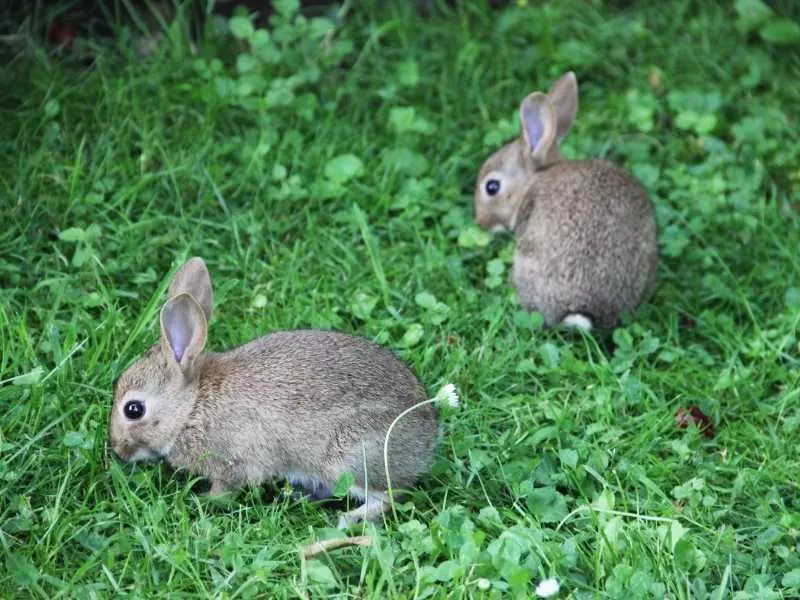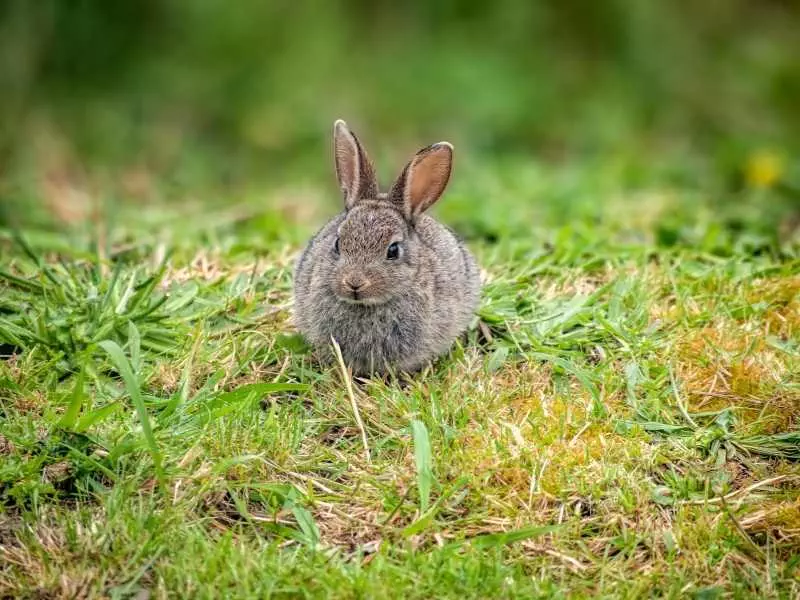

Wild rabbit do not do well in captivity, Only take one if there mother has really abandoned them
Wild rabbit are not like domestic rabbits . Different wild rabbits have different nutritional and dietary needs. Domestic rabbits can usually eat the same diet as their wild cousins, but keep in mind that just because they can doesn't mean they should.
Domestic rabbits are more resilient to a small amount of abnormalities in their diet than their wild counterparts; they will not die from a few days of eating something new while a wild rabbit may only last a day or two before it begins to starve since it cannot adapt as easily as an established pet.
When you are approached by a baby rabbit in the wild, it is tempting to feed it. The animal is cute and you want to help. However, do not feed a wild baby bunny under any circumstances! Baby rabbits are very prone to intestinal blockages from human food and water.
If you see a baby rabbit that is shivering, weak, or suffering from diarrhea or other digestive problems, it is probably not able to digest food.
You might also notice its eyes are closed and its ears are floppy. These are all signs of a wild baby bunny that is suffering from malnutrition due to improper feeding by humans.
When you are approached by an injured or abandoned baby rabbit in the wild, please contact a local wildlife rehabilitation center for advice on what you can do to help the animal.
The first thing you can do is make sure it really needs to be fed. The animal may not need to be captive fed at all, and may get better on its own.
Contact your local wildlife rehabilitation center to find out what you can do to help. If the baby is suffering from an injury or illness, it may not need to be fed at all until it recovers. The food it has eaten may cause more problems than it helps at this point.

Some people offer human baby food in a bottle wrapped with duct tape because they think the animal will get used to the bottle and will eventually become tame enough for them to care for.
It doesn't work that way. Rabbits are afraid of humans and will instinctively fight against the cage or enclosure they are kept in to protect themselves.
If you find a wild bunny that is injured or abandoned, contact your local wildlife rehabilitation center to make sure the animal truly needs your help and isn't just separated from its mother.
Mother rabbits will try to hide their babies in thick grass or underbrush so you may not be able to see them. If the animal is truly an orphan, however, it will need assistance fast or it can suffer from injury and illness before it is found.
Baby rabbits are very easy to identify. They have soft, downy white fur with no adult markings. When they are born, their ears will begin to open and they will molt the first time. The molt lasts about a week and the baby takes on its adult color after this period.
Not all baby wild rabbits survive. The majority of baby wild rabbits die within a few months of being born, and those that do live will rarely live more than a year.
Baby rabbits will be effectively abandoned by their mothers if they do not keep up with the rest of the group, or if their mother is killed during a hunt.
It is possible that it is the mother's instinct to leave them behind to protect them from danger, but you cannot rely on this instinct keeping your bunny alive. You must learn to care for an abandoned wild rabbit on your own.

You can also try to locate the mother and watch her. Sometimes bunnies just leave their babies for a few minutes and then come back. If you know where the mother is, you can wait a few days to see if she returns.
Even if the baby looks helpless, it is best not to intervene unless you are sure that it needs your help. Mother rabbits will try to hide their nests in thick grass and underbrush so that predators cannot get to them.
Baby wild rabbits are very adaptable to changing conditions and can survive well on almost any diet you can offer them. The following is a list of foods that are most commonly offered to baby wild rabbits. However, if you simply notice that your baby rabbit is doing okay, then there are no specific problems with its diet, you don't need to worry so much.
In the wild, baby wild rabbits tend to hide when they are sick and only come out when they need feeding or when they feel safe.
Observing these signs can prevent feeding them too much or too little.
When your orphan is healthy, it should be bright and lively with shiny eyes and a good appetite. A sick baby wild rabbit, on the other hand, will appear much less active and may not want food at all.

Kitten Milk Replacer (KMR) or goat milk is recommended for feeding baby wild rabbits. KMR is a human product, but if you are not comfortable using it, you can use goat milk instead.
If neither of these are available, plain cow's milk can be used as a last resort. Baby wild rabbits need this milk to maintain their body temperature and to develop normally.
For your small kitten or rabbit, a bottle is the answer for feeding. You will need a clean medicine dropper (18 to 24 gauge) or syringe without the needle.
It is very important to know how old your baby wild rabbit is. If you are not sure, you can try this method:
1) Count the number of molars the bunny has. A baby rabbit will have two molars on top and one on bottom, for a total of three. After about four weeks of age, you should be able to see these little teeth through the gum line.
2) Count the number of furrows in the bunny's ear. A baby rabbit has six to eight furrows. After about four weeks, you may see these little lines on your baby wild rabbit's ear.
Yes, you can raise a wild baby rabbit and when it is ready to go back in the wild, it will know how to survive.
You must remember that baby wild rabbits are very fragile and require special care. Keeping them warm and safe from harm is important. The best way to ensure their safety is to handle them as little as possible and always wash your hands before handling them again.
If you do not feel comfortable raising a wild baby rabbit on your own, contact your local wildlife rehabilitation agency for advice.
Wild baby rabbits don't survive well in captivity. If possible, leave them where they are found. Their mother will continue to care for them in their natural habitat.
If you want to keep your wild baby rabbits warm, a heat lamp is necessary. A heat lamp is best placed in front of the nest box and should be placed so that it shades the area where the nest is located, making it warmer for them.
Not only will a heat lamp help keep your babies warm, but it will also help protect their delicate eyes from harmful UV light.
A heat lamp may be made with a regular incandescent bulb or ceramic heating element(s), but do not over use it. Between 10 and 20 degrees is considered to be a safe temperature for baby wild rabbits.
If you want to pick up or handle a wild rabbit, the best thing to do is wait until the animal is calm and willing. Make sure you do not approach a wild baby rabbit if it looks scared or if its ears are fluffed back in fear.
Handling can also trigger stress in baby rabbits . Some people think it is a good idea to handle baby wild rabbits regularly, but it can actually suppress their immune system and cause them to die faster.
Do not pick up your wild baby rabbit by the ears, tail, or hind legs. This can cause injury and stress to your pet. Instead, make sure you always have a soft blanket or towel to place it on when you are ready to pick it up. Always wash your hands before holding or handling a wild baby bunny again.
EarsToday is a participant in the Amazon Services LLC Associates Program, an affiliate advertising program.
Please enter search query below:

I love animals. They make me happy and they make me feel better when I'm down.
They make me want to be a better person and I love them regardless of what they look like, regardless of how they're different from me.
I love all animals regardless of what they look like or how they're different from me.
These are some of our most popular posts
These are some of our most popular posts
Click on the links for our Social Media
Amazon Affiliate
HutchAdvice.Com
95 Sunrising, East Looe. Cornwall.
PL13 1NG, United Kingdom
Tel: 07593 076598
Designed And Developed By 8r1ght.com